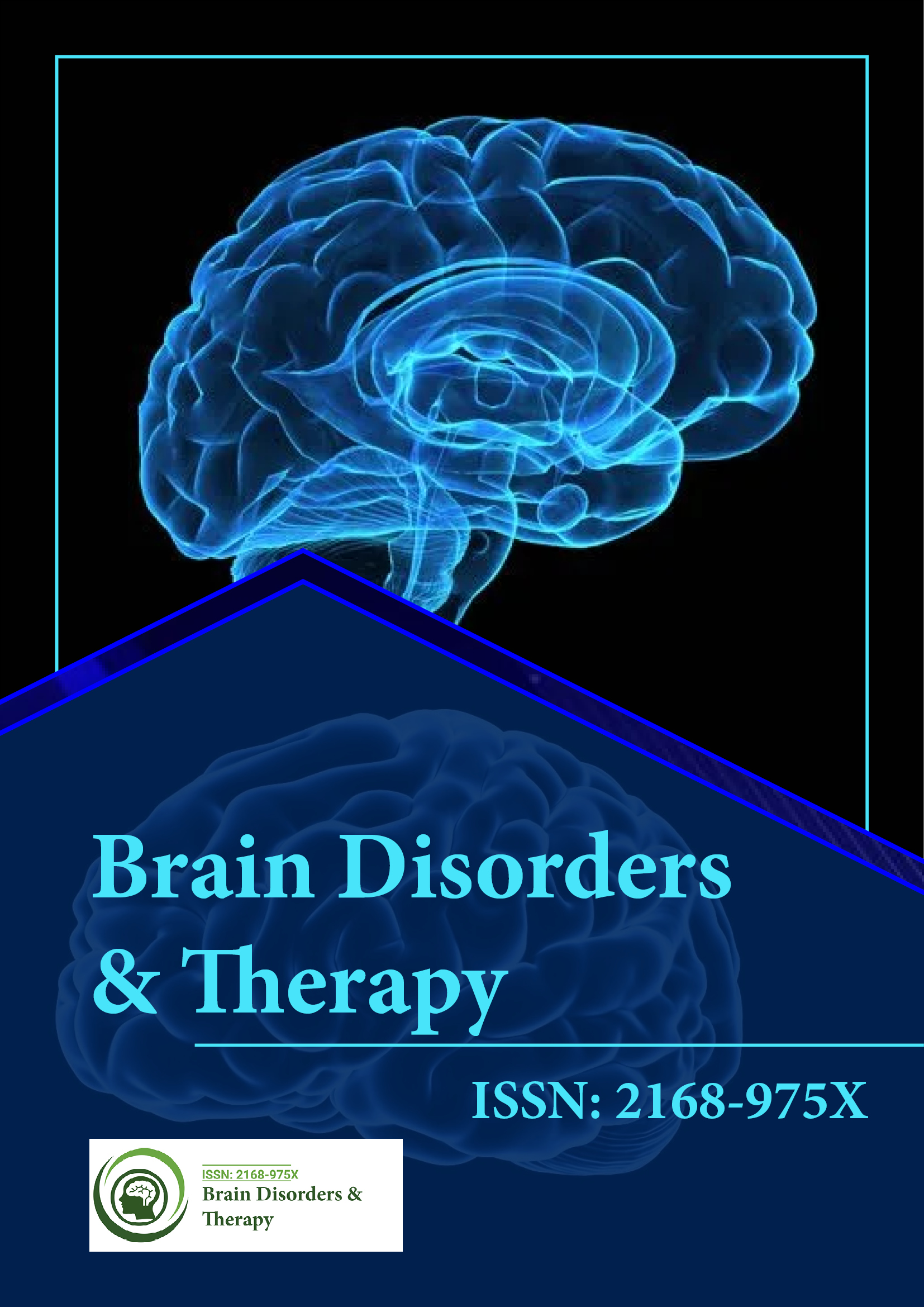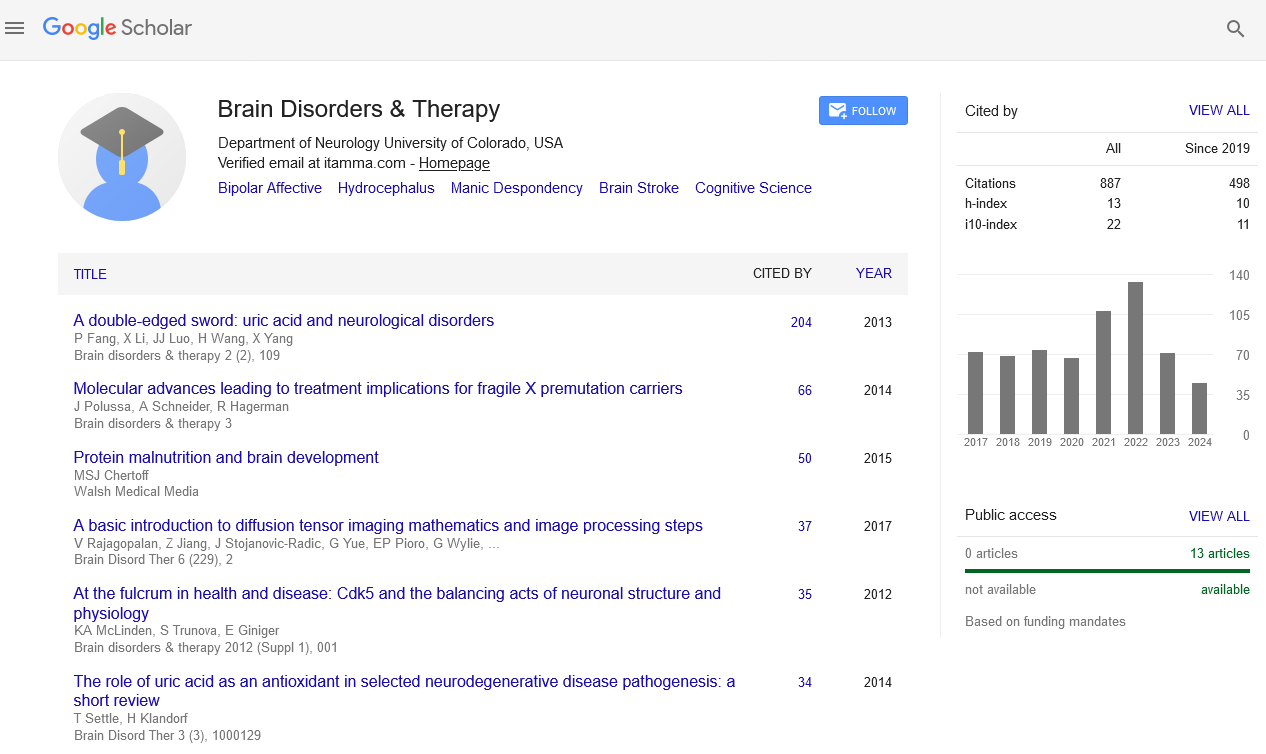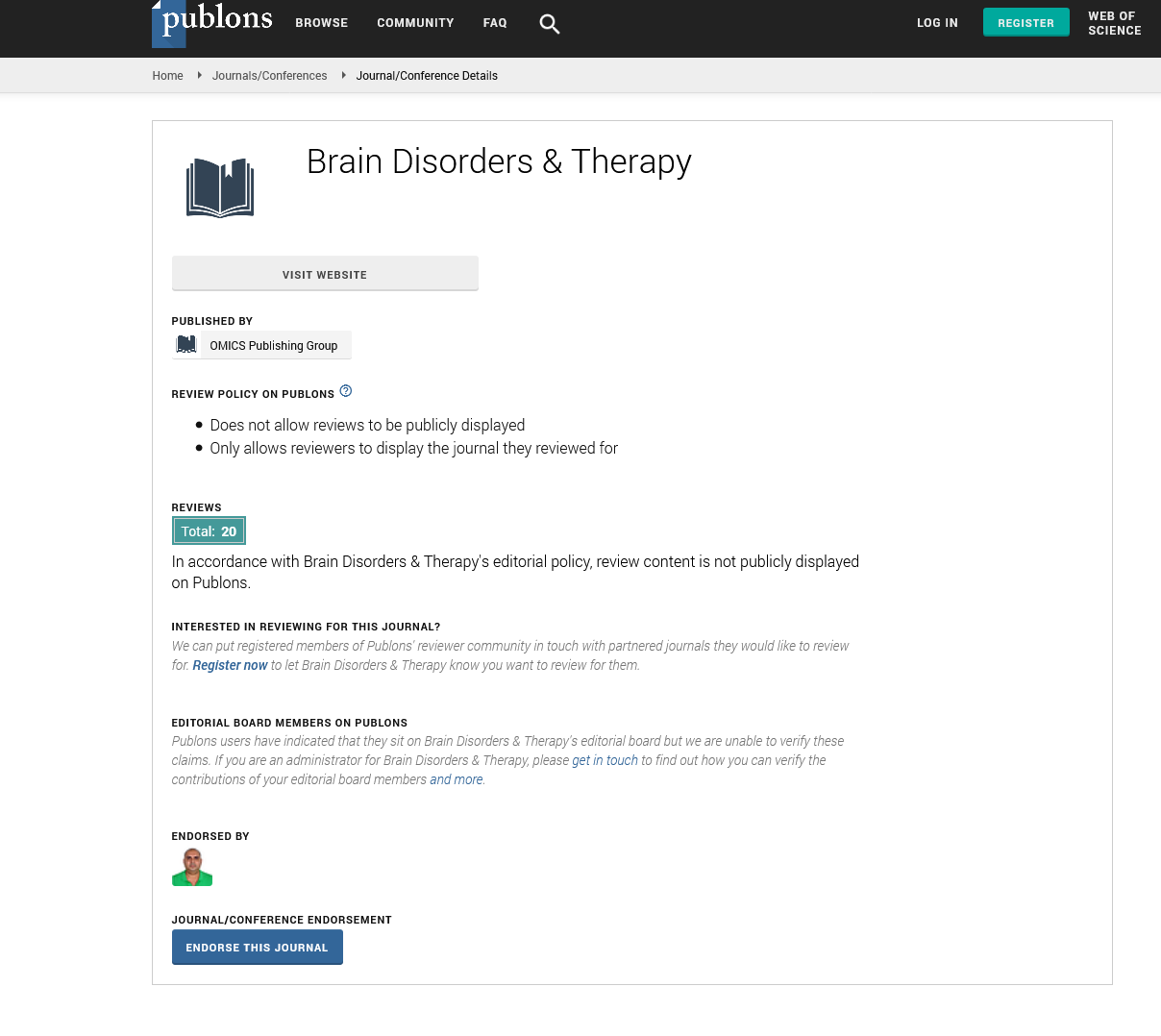Indexed In
- Open J Gate
- Genamics JournalSeek
- JournalTOCs
- RefSeek
- Hamdard University
- EBSCO A-Z
- OCLC- WorldCat
- Publons
- Geneva Foundation for Medical Education and Research
Useful Links
Share This Page
Journal Flyer

Open Access Journals
- Agri and Aquaculture
- Biochemistry
- Bioinformatics & Systems Biology
- Business & Management
- Chemistry
- Clinical Sciences
- Engineering
- Food & Nutrition
- General Science
- Genetics & Molecular Biology
- Immunology & Microbiology
- Medical Sciences
- Neuroscience & Psychology
- Nursing & Health Care
- Pharmaceutical Sciences
Short Communication - (2025) Volume 14, Issue 2
Clinical Utility of Plasma Indicators and MRI in Preclinical Alzheimerâs Identification
Kathryn Brodaty*Received: 26-May-2025, Manuscript No. BDT-25-29718; Editor assigned: 28-May-2025, Pre QC No. BDT-25-29718 (PQ); Reviewed: 11-Jun-2025, QC No. BDT-25-29718; Revised: 18-Jun-2025, Manuscript No. BDT-25-29718 (R); Published: 25-Jun-2025, DOI: 10.35248/2168-975X.25.14.298
Description
Alzheimer’s Disease (AD) continues to be a global challenge with limited therapeutic success in modifying its progression. Early identification of individuals suitable for disease-modifying interventions is essential to improve clinical outcomes and support effective resource allocation. Recent advances in plasma-based biomarkers and structural Magnetic Resonance Imaging (MRI) have opened avenues for combined diagnostic models. This article explores how plasma biomarkers, when used alongside structural MRI, enhance the identification of individuals with early neurodegenerative changes. It discusses the individual and synergistic performance of these tools, evaluates their reliability and highlights their clinical applicability in selecting candidates for potential disease-modifying trials.
Alzheimer’s disease is the most prevalent form of dementia and is marked by progressive cognitive decline and characteristic pathological changes, including amyloid-beta plaques, tau tangles and neurodegeneration. Despite extensive research efforts, the timely recruitment of individuals into disease-modifying therapy trials remains difficult. This is largely due to the diagnostic ambiguity in early stages and the high cost and invasiveness of standard biomarker assessments like Cerebrospinal Fluid (CSF) analysis and Positron Emission Tomography (PET).
In recent years, non-invasive and scalable tools such as plasma-based biomarkers and structural MRI have gained momentum. Plasma assays targeting amyloid and tau pathology, as well as neurodegeneration-associated proteins, have shown significant diagnostic relevance. When integrated with neuroimaging data reflecting brain volume loss and cortical thinning, the predictive accuracy improves. This combined model has the potential to identify candidates at risk for Alzheimer’s progression prior to irreversible cognitive deterioration.
Combined use of plasma biomarkers and MRI
The integration of plasma biomarkers and MRI addresses the limitations inherent to either modality used alone. While plasma assays detect molecular changes, structural MRI reveals anatomical evidence of neuronal damage. Together, they form a comprehensive framework for stratifying participants according to disease progression risk [1-3].
Early identification
Individuals with Mild Cognitive Impairment (MCI) or preclinical Alzheimer’s may not meet clinical criteria for dementia but can still exhibit subtle changes detectable by this combined approach. These individuals represent ideal candidates for disease-modifying interventions, as therapeutic benefit is maximized before extensive neuron loss occurs.
Utility in trial enrollment
Pharmaceutical trials targeting early Alzheimer’s pathology require high specificity in recruiting participants who are on a confirmed disease trajectory. Using plasma-MRI combinations can lower screen-failure rates and reduce dependence on invasive procedures like lumbar puncture or costly PET scans [4,7].
Strengths of the combined approach
Blood-based tests are significantly less expensive than PET or CSF studies. MRI scanners, though costly, are widely available in clinical and research settings. Combining the two can scale early detection efforts without burdening healthcare systems.
Integration minimizes false positives. For instance, isolated elevation can occur in other neurological diseases; pairing with hippocampal volume loss improves diagnostic precision for Alzheimer’s.
Compared to lumbar puncture, plasma sampling is more acceptable to patients and facilitates repeated measures across time points to track disease progression [8,10].
Conclusion
The combination of plasma biomarkers with structural MRI represents a significant advancement in Alzheimer’s disease research and clinical strategy. This dual-modality approach increases diagnostic confidence, supports early identification and facilitates targeted recruitment into disease-modifying therapy trials. As assay standardization and imaging technology evolve, the clinical application of this approach is likely to expand, offering a more efficient and less invasive pathway for managing and studying Alzheimer’s disease.
References
- Ramesh M, Govindaraju T. Multipronged diagnostic and therapeutic strategies for Alzheimer's disease. Chem Sci. 2022;13(46):13657-13689.
- Mahaman YA, Embaye KS, Huang F, Li L, Zhu F, Wang JZ, et al. Biomarkers used in Alzheimer’s disease diagnosis, treatment, and prevention. Ageing Res Rev. 2022;74:101544.
- Therriault J, Zimmer ER, Benedet AL, Pascoal TA, Gauthier S, Rosa-Neto P. Staging of Alzheimer’s disease: Past, present, and future perspectives. Trends Mol Med. 2022;28(9):726-741.
- Li Y, Liu T, Zeng Q, Cui M. Current status of PET tracers for the early diagnosis of Alzheimer's disease. TrAC Trends Anal Chem. 2024;172:117546.
- Pascoal TA, Aguzzoli CS, Lussier FZ, Crivelli L, Suemoto CK, Fortea J, et al. Insights into the use of biomarkers in clinical trials in Alzheimer's disease. EBioMedicine. 2024;108.
- Lista S, Mapstone M, Caraci F, Emanuele E, Lopez-Ortiz S, Martin-Hernandez J, et al. A critical appraisal of blood-based biomarkers for Alzheimer’s disease. Ageing Res Rev. 2024;96:102290.
- Gao W, Jing S, He C, Saberi H, Sharma HS, Han F, et al. Advancements in neurodegenerative diseases: pathogenesis and novel neurorestorative interventions. J Neurorestoratol. 2025;13(2):100176.
- Hussain N, Khan MM, Sharma A, Singh RK, Khan RH. Beyond plaques and tangles: The role of Immune Cell Dysfunction in Alzheimer’s disease. Neurochem Int. 2025:105947.
- Kwon MJ, Park J, Jo S, Kim JS, Lee H, Oh DJ, Han JW, Kim KW. Unraveling SNAP: Distinct patterns of early neurodegeneration through MRI texture analysis. Neuroimage Clin. 2025;47:103829.
- Liu Y, Wu L, Peng W, Mao X. Glial polarization in neurological diseases: Molecular mechanisms and therapeutic opportunities. Ageing Res Rev. 2025;104:102638.
Citation: Brodaty K (2025). Clinical Utility of Plasma Indicators and MRI in Preclinical Alzheimer’s Identification. Brain Disord Ther. 14:298
Copyright: © 2025 Brodaty K. This is an open-access article distributed under the terms of the Creative Commons Attribution License, which permits unrestricted use, distribution, and reproduction in any medium, provided the original author and source are credited.


